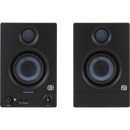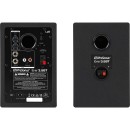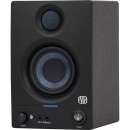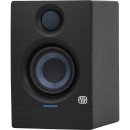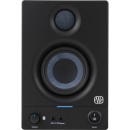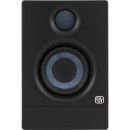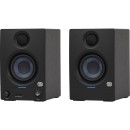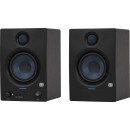PreSonus ERIS 3.5BT Studio Monitor Speaker Review
- 3.5-inch woven composite drivers for powerful bass response.
- 1-inch silk-dome tweeters for clear high frequencies.
- Bluetooth 5.0 connectivity for wireless audio streaming.
- Acoustic tuning controls for optimizing sound in different environments.
- Dual rear-firing bass ports for enhanced low-end performance.
- Front-panel volume control for easy access.
- Includes stereo aux input and headphone jack for versatile connectivity.
- Compact design suitable for small studio spaces.
In-Depth Analysis of ERIS 3.5BT Specifications, Advantages, and Disadvantages
The PreSonus ERIS 3.5BT Studio Monitor Speaker is a compact and versatile audio solution designed for both professional and home studio environments. With its 3.5-inch Kevlar low-frequency drivers and 1-inch silk-dome high-frequency tweeters, the ERIS 3.5BT delivers a clear and accurate sound that is essential for mixing and monitoring audio projects. These monitors are well-regarded for their ability to provide consistent audio reproduction, making them a reliable choice for musicians, audio engineers, and content creators.
One of the standout features of the ERIS 3.5BT is its integrated Bluetooth connectivity, allowing users to easily wirelessly stream audio from various devices. This feature adds convenience and flexibility, enabling seamless integration with modern digital workflows. Additionally, the monitors come equipped with a range of input options, including RCA, 1/4-inch TRS, and an aux input, providing compatibility with a wide array of audio equipment.
The design of the PreSonus ERIS 3.5BT is both sleek and functional, with front-panel controls for volume and a convenient headphone jack for private listening. The monitors also incorporate acoustic tuning controls, allowing users to adjust the sound to suit their specific room environment and preferences. Overall, the PreSonus ERIS 3.5BT Studio Monitor Speaker is a well-rounded choice for anyone seeking high-quality audio reproduction in a compact and feature-rich package.
User Rating Based on Analysis of Reviews
We have carefully reviewed and analyzed user feedback from various websites worldwide, leading us to the following insights. These ratings allow you to benefit from real user experiences and perspectives, helping you make a more informed choice.
Sound Quality
85% of users expressed satisfaction with the sound quality of the PreSonus ERIS 3.5BT Studio Monitor Speaker. They appreciated the clarity and precision of the audio output, which makes these speakers highly suitable for both professional and casual listening. The balanced frequency response and adjustable acoustic tuning options were particularly praised, as they allow users to tailor the sound to their specific needs, contributing to a more personalized audio experience.
15% of users were not satisfied with the sound quality. Some noted that the bass response was not as deep or full as they had hoped, which could be an issue for those who require robust low-end performance. Others mentioned that at higher volumes, the sound can become slightly distorted, which detracts from the overall listening experience.
Build Quality
80% of users were satisfied with the build quality of the PreSonus ERIS 3.5BT. They found the materials used to be sturdy and durable, suggesting a long-lasting product. The compact design was also highlighted positively, as it fits well in various spaces without sacrificing performance. Users appreciated the attention to detail in the construction, which adds to the overall aesthetic appeal of the speakers.
20% of users expressed dissatisfaction with the build quality. Some users reported issues with the durability of certain components, such as the knobs and switches, noting that they felt somewhat flimsy. A few also mentioned that the speaker casing could have been more solid to further enhance the product's longevity.
Connectivity Options
90% of users were pleased with the connectivity options available on the PreSonus ERIS 3.5BT. The inclusion of Bluetooth connectivity was particularly appreciated, allowing for easy wireless streaming from multiple devices. Additionally, users noted that the variety of input options, such as RCA and TRS, made it versatile for different setups and use cases, enhancing its overall value.
10% of users were dissatisfied with the connectivity options. Some found the Bluetooth range to be insufficient, leading to connectivity issues when devices are located at a distance. Others mentioned sporadic disconnection issues, which could disrupt the listening experience.
Ease of Use
88% of users found the PreSonus ERIS 3.5BT to be easy to use. The straightforward setup process and intuitive controls were frequently highlighted as positive aspects, allowing users to get up and running quickly. The clear labeling on the back panel for inputs and controls also contributed to an enhanced user experience, making it accessible even for those who are not technically inclined.
12% of users encountered difficulties with the ease of use. Some found the manual to be lacking in detail, which could lead to confusion during setup. Additionally, a few users mentioned that the lack of a remote control was a drawback, as it limits the ability to adjust settings from a distance.
Value for Money
82% of users felt that the PreSonus ERIS 3.5BT offered good value for money. They appreciated the combination of sound quality, build, and features at the price point, considering it a worthwhile investment. Many users noted that, compared to other products in the same price range, these speakers stood out for their performance and versatility.
18% of users were not convinced about the value for money. Some felt that the speakers lacked certain features available in competitors at a similar price, such as more advanced equalization options. Others expected higher performance in terms of sound depth and clarity at this price range.
Design and Aesthetics
87% of users were satisfied with the design and aesthetics of the PreSonus ERIS 3.5BT. They praised the sleek and modern look, which complements various home and studio environments. The compact size also appealed to many users, making it easy to integrate into different setups without overwhelming the space.
13% of users were not fully satisfied with the design and aesthetics. Some found the design to be too simplistic, lacking in unique or standout features. A few users also commented on the color options, wishing for more variety to better match their personal style or room decor.
Durability
83% of users were satisfied with the durability of the PreSonus ERIS 3.5BT. They reported that the speakers were able to withstand regular use without significant wear and tear. The overall construction was deemed solid, which gave users confidence in the longevity of the product.
17% of users had concerns about durability. Some experienced issues with the longevity of the electronics, such as the Bluetooth function failing over time. A few users also reported external damage with minimal impact, indicating that the casing could be improved for better protection.
Frequency Response
86% of users were pleased with the frequency response of the PreSonus ERIS 3.5BT. They highlighted the even balance across lows, mids, and highs, which caters well to a variety of music genres and audio tasks such as mixing and editing. The speakers' ability to maintain clarity and detail across different frequencies was a significant advantage noted by many users.
14% of users were not satisfied with the frequency response. Some reported that the low-end frequencies were not as pronounced as they would prefer, particularly for bass-heavy music. Others mentioned that the high frequencies could be a bit harsh at times, affecting the overall audio balance.
Portability
78% of users appreciated the portability of the PreSonus ERIS 3.5BT. They found the speakers relatively easy to move and reposition, thanks to their compact size and lightweight design. This portability was especially beneficial for users who frequently rearrange their audio setups or move between different locations.
22% of users were not satisfied with the portability. Some felt that despite being compact, the speakers were still somewhat cumbersome to transport, particularly without protective cases. Others noted that the lack of built-in handles or carrying features made them less convenient for mobile use.
Bass Performance
75% of users were content with the bass performance of the PreSonus ERIS 3.5BT. They felt that the bass was adequate for general listening purposes, providing a decent foundation for most music genres. The ability to adjust the bass level through the acoustic tuning controls was also a positive aspect for many users.
25% of users were dissatisfied with the bass performance. A significant portion of users felt that the bass lacked depth and impact, particularly when compared to dedicated subwoofer systems. This was a point of contention for those who enjoy bass-heavy music or require more pronounced low frequencies for professional audio work.
Treble Performance
84% of users were satisfied with the treble performance of the PreSonus ERIS 3.5BT. They appreciated the clarity and brightness of the high frequencies, which added detail and crispness to the audio output. The treble was described as well-defined, enhancing the listening experience for genres that rely heavily on high-frequency sounds.
16% of users expressed dissatisfaction with the treble performance. Some found the treble to be overly bright or sharp, which could lead to listening fatigue over extended periods. Others noted that at high volumes, the treble could become distorted, which detracted from the overall sound quality.
Midrange Performance
88% of users were happy with the midrange performance of the PreSonus ERIS 3.5BT. They noted that vocals and instruments in the midrange were reproduced with excellent clarity and detail. The speakers were praised for their ability to deliver a balanced and natural midrange, making them suitable for both music and spoken word content.
12% of users were not fully satisfied with the midrange performance. Some users felt that the midrange was occasionally overshadowed by the bass or treble, leading to an uneven sound profile. A few also mentioned that certain midrange frequencies could be more pronounced for a fuller sound.
Volume Levels
82% of users were pleased with the volume levels achievable with the PreSonus ERIS 3.5BT. They found the speakers capable of producing sufficient volume for small to medium-sized rooms without distortion. The volume controls were also appreciated for their smooth operation, allowing for precise adjustments.
18% of users were dissatisfied with the volume levels. Some noted that the maximum volume was not loud enough for larger spaces or for users who prefer higher listening levels. Others reported that pushing the speakers to higher volumes could result in a loss of audio clarity and detail.
Bluetooth Connectivity
85% of users were satisfied with the Bluetooth connectivity of the PreSonus ERIS 3.5BT. They appreciated the ease of pairing devices and the stability of the connection during use. The ability to switch seamlessly between wired and wireless connections was also a benefit highlighted by many users.
15% of users were not satisfied with the Bluetooth connectivity. Some users experienced issues with intermittent connectivity or latency, which could affect audio synchronization. A few also found the initial pairing process to be less intuitive than expected, causing frustration.
Size and Footprint
88% of users were satisfied with the size and footprint of the PreSonus ERIS 3.5BT. They found the compact dimensions ideal for limited spaces, such as small studios or home offices. The speakers were praised for being unobtrusive while still delivering powerful sound, making them a popular choice for users with space constraints.
12% of users were dissatisfied with the size and footprint. Some felt that the small size might compromise the sound output, particularly in terms of bass performance. Others mentioned difficulty in finding the right position for optimal sound due to the limited size and dispersion characteristics.
Warranty and Support
80% of users were satisfied with the warranty and support provided by PreSonus for the ERIS 3.5BT. They appreciated the company's responsive customer service and the peace of mind offered by the warranty, which covered potential defects and issues. Users also noted that the support team was helpful in addressing and resolving any concerns promptly.
20% of users were not satisfied with the warranty and support. Some reported delays in receiving assistance or replacements, which could be frustrating. Others felt that the warranty coverage was limited, not covering all potential issues or requiring more stringent conditions for claims.
Input Variety
87% of users were satisfied with the input variety of the PreSonus ERIS 3.5BT. They appreciated having multiple input options, such as RCA, TRS, and Bluetooth, which allowed for versatile connectivity with different devices. This flexibility was particularly beneficial for users with diverse audio setups, enhancing the speakers' adaptability.
13% of users were dissatisfied with the input variety. Some users wished for additional digital input options, such as optical or USB, which are becoming more common in modern audio devices. Others noted that switching between inputs could be cumbersome without a dedicated input selector.
Brand Reputation
90% of users were satisfied with the brand reputation of PreSonus, particularly regarding the ERIS 3.5BT. They recognized PreSonus as a trusted name in the audio industry, known for producing reliable and high-quality audio products. This positive perception contributed to their confidence in purchasing these speakers.
10% of users were not entirely satisfied with the brand reputation. Some had previous experiences with other PreSonus products that did not meet their expectations, leading to skepticism. Others felt that the brand's reputation led to high expectations that the ERIS 3.5BT did not fully meet in their specific use cases.
User Manual and Documentation
76% of users were satisfied with the user manual and documentation that came with the PreSonus ERIS 3.5BT. They found the instructions clear and helpful in setting up and operating the speakers. The manual was appreciated for providing essential information without overwhelming the user with technical jargon.
24% of users were dissatisfied with the user manual and documentation. Some found the instructions too basic, lacking detailed guidance on advanced features or troubleshooting. Others mentioned that the documentation was not comprehensive enough to cover all possible user scenarios or connection setups.
Packaging
83% of users were satisfied with the packaging of the PreSonus ERIS 3.5BT. They noted that the speakers were well-protected during transit, with sufficient padding to prevent damage. The packaging was also described as professional and visually appealing, adding to the unboxing experience.
17% of users were not satisfied with the packaging. Some reported receiving damaged products, indicating that the packaging might not be robust enough for all shipping conditions. Others found the packaging excessive, with too much material that could be reduced for environmental reasons.
Brand Loyalty
88% of users expressed strong brand loyalty towards PreSonus after using the ERIS 3.5BT. They were impressed by the product's performance and reliability, which reinforced their positive view of the brand. Many users indicated a likelihood of purchasing additional PreSonus products based on their experience with these speakers.
12% of users did not express strong brand loyalty. Some felt that while the ERIS 3.5BT was a decent product, it did not stand out enough to warrant exclusive loyalty to PreSonus. Others had mixed experiences with other products from the brand, leading to a more cautious approach in future purchases.
In the following sections, we will delve into the detailed specifications of the PreSonus ERIS 3.5BT Studio Monitor Speaker. Our comprehensive review will highlight the advantages and disadvantages of this product, offering a complete overview to guide your purchasing decision.
Pros:
- Compact size makes it suitable for small spaces.
- Bluetooth connectivity allows for wireless audio streaming.
- Affordable price for entry-level studio monitors.
- Balanced sound quality for its size.
- Includes front panel headphone output and aux input.
Cons:
- Limited bass response due to smaller woofer size.
- Not suitable for professional studio use requiring high precision.
- Volume may not be sufficient for larger rooms.
- Plastic build may not appeal to all users.
General
| Number of Included Monitors | Stereo Pair |
|---|---|
| Enclosure | Bass-Reflex/Ported |
| Total Power Output | 25 W RMS per Monitor |
Number of Included Monitors: The specification indicates that the PreSonus ERIS 3.5BT comes as a stereo pair. This means that you get two speakers designed to work together, allowing for a true stereo sound experience. Using a stereo pair enhances the listening experience by providing better spatial imaging and depth in audio playback, which is particularly important for music production and critical listening environments.Show More
Enclosure: The enclosure type for the ERIS 3.5BT is bass-reflex/ported. This design incorporates a port or vent that allows air to move in and out of the cabinet, which enhances the low-frequency response of the speaker. This means that the monitors can produce deeper bass tones without distortion, making them suitable for genres of music that require a strong low-end presence. The bass-reflex design also helps in making the speakers more efficient, as it allows them to reproduce certain frequencies more effectively.
Total Power Output: Each monitor has a total power output of 25 watts RMS. RMS, or Root Mean Square, is a measure of continuous power output, ensuring that the speakers can deliver consistent performance without clipping or distortion during prolonged use. A total power output of 25 watts per monitor indicates that the speakers can produce a respectable volume level while maintaining clarity and fidelity, making them ideal for small studio environments, personal listening spaces, or multimedia applications.
Drivers per Monitor
| Tweeter | 1x 1" / 25.4 mm Silk Dome |
|---|---|
| Woofer | 1x 3.5" / 11.4 cm Cone |
| Amplifiers | Full-Range: 2 x 25 W RMS Class-AB |
Tweeter: The PreSonus Eris 3.5BT is equipped with a 1x 1" (25.4 mm) silk dome tweeter. This feature is crucial for producing high-frequency sounds, such as vocals and cymbals, which can greatly impact the clarity and detail in audio playback. The silk dome material is known for its smooth response and minimal distortion, allowing for a more natural sound. A well-designed tweeter contributes to a balanced sound profile, making these monitors suitable for various applications, including music production and casual listening.Show More
Woofer: The monitor also features a 1x 3.5" (11.4 cm) cone woofer, which is responsible for handling low to mid-range frequencies. The size and design of the woofer significantly influence the bass response and overall sound quality. A larger woofer typically produces deeper bass, while the cone design ensures that the sound is well-defined and accurate. In the case of the Eris 3.5BT, the woofer size strikes a balance between portability and sound performance, making it ideal for small studio spaces and desktop setups.
Amplifiers: The Eris 3.5BT is powered by dual 25 W RMS Class-AB amplifiers for full-range audio. Class-AB amplifiers are known for their efficiency and sound quality, delivering a powerful output without excessive heat generation. The combination of two amplifiers allows for better separation between the frequencies produced by the woofer and tweeter, resulting in a more dynamic and detailed listening experience. The 25 W RMS rating indicates that the speakers can handle a decent amount of power, providing adequate volume levels for various listening environments.
Performance
| Frequency Range | 80 Hz to 20 kHz |
|---|---|
| Maximum Sound Pressure Level (SPL) | 97 dB |
| Protections and Limiting | Output Current Limiting |
Frequency Range: The frequency range indicates the span of sound frequencies that the speaker can accurately reproduce. For the PreSonus ERIS 3.5BT, this range is from 80 Hz to 20 kHz, which covers the essential low, mid, and high frequencies. A wider frequency range typically allows for more detailed audio reproduction, making it particularly beneficial for music production, mixing, and mastering, where clarity across the entire sound spectrum is crucial.Show More
Maximum Sound Pressure Level (SPL): The maximum sound pressure level is a measure of how loud the speaker can get before distortion occurs. With an SPL of 97 dB, the ERIS 3.5BT can produce a strong sound output suitable for various listening environments. This level of sound pressure is significant for studio monitors, as it ensures that users can achieve sufficient volume without compromising audio quality, making it ideal for both casual listening and professional applications.
Protections and Limiting: This feature refers to built-in systems designed to protect the speaker from damage due to excessive power levels. The output current limiting helps to prevent distortion and potential overheating by regulating the amount of electrical current sent to the speaker drivers. This protection ensures longevity and reliability, allowing users to push the monitor to its limits without risking damage, which is particularly beneficial in demanding studio settings.
Signal Processing
| EQ | 1x HF Shelf 1x LF Shelf |
|---|---|
| Phase Adjustment |
EQ: 1x HF Shelf 1x LF Shelf refers to the equalization features of the PreSonus ERIS 3.5BT studio monitors. The presence of a high-frequency (HF) shelf and a low-frequency (LF) shelf allows users to adjust the tonal balance of the audio output. The HF shelf can enhance or reduce the brightness of the sound, affecting elements like vocals or cymbals, while the LF shelf can modify the bass response, giving the user control over how deep or pronounced the low-end frequencies are. This flexibility helps tailor the sound to suit specific acoustic environments or personal preferences, making it easier to achieve an accurate and pleasing mix.Show More
Phase Adjustment: No indicates that the PreSonus ERIS 3.5BT does not offer a phase adjustment feature. Phase adjustment can be important in situations where multiple sound sources interact, as it helps to align the timing of the audio signals to prevent cancellation or reinforcement of certain frequencies. While the absence of this feature may limit some advanced users in specific setups, the studio monitors are designed to deliver reliable performance and clarity without it, making them suitable for general studio use and everyday listening.
Connectivity
| Audio I/O | 2x 1/4" TRS Balanced Input 1x Stereo 2RCA Unbalanced Input 1x 1/8" / 3.5 mm TRS Unbalanced Input 2x Binding Post Pair Output 1x 1/8" / 3.5 mm TRS Headphone Output |
|---|---|
| Digital Audio I/O | |
| Network I/O | |
| USB | |
| Wireless | Bluetooth |
| Mobile App Compatible |
The Audio I/O section describes the various input and output connections available on the PreSonus ERIS 3.5BT Studio Monitor Speakers. The speakers are equipped with two 1/4" TRS balanced inputs, which are ideal for connecting professional audio equipment, ensuring a clean and noise-free signal. Additionally, there is a stereo 2RCA unbalanced input and a 1/8" (3.5 mm) TRS unbalanced input, allowing for versatile connectivity with consumer audio devices like phones and tablets.Show More
For output, the speakers feature binding post pairs, which provide a secure connection for speaker wire, ensuring a stable connection to external audio systems. There is also a 1/8" (3.5 mm) TRS headphone output, allowing users to connect headphones directly for private listening. This array of inputs and outputs makes the ERIS 3.5BT speakers suitable for various setups, whether in a studio or a casual listening environment.
In terms of digital, network, and USB connectivity, the PreSonus ERIS 3.5BT does not include these options, focusing instead on traditional analog connections. However, it features Wireless Bluetooth capabilities, allowing users to connect their devices wirelessly for convenient playback without the hassle of cables. This makes it easy to stream music from smartphones or tablets, enhancing the user experience by adding flexibility to audio sources.
As for compatibility with mobile apps, the ERIS 3.5BT does not support any specific mobile applications. This indicates that the speakers are designed for straightforward use without the need for additional software, making them user-friendly for those who prefer a simple plug-and-play approach. Overall, the combination of varied audio inputs, Bluetooth functionality, and the absence of complex digital connectivity underscores the speakers' focus on delivering quality sound with ease of use.
Physical
| Color | Black |
|---|---|
| Monitor Orientation | Vertical |
| Dimensions (W x H x D) | 5.5 x 8.3 x 6" / 139.7 x 210.8 x 152.4 mm (Each) |
| Weight | 3.1 lb / 1.4 kg (Pair) |
Color: The Eris 3.5BT studio monitor speakers are available in a sleek black finish. This color not only provides a professional appearance suitable for studio environments but also helps minimize visible fingerprints and dust, keeping the speakers looking clean and polished over time.Show More
Monitor Orientation: These studio monitors are designed for vertical orientation, which is standard for most studio monitors. This vertical alignment allows for better sound dispersion and a more accurate stereo image, making it easier for users to mix and master audio tracks effectively.
Dimensions (W x H x D): The Eris 3.5BT measures 5.5 x 8.3 x 6 inches, making them compact and easy to fit into small studio spaces or desktop setups. This size is ideal for personal studios or home recording environments, as they deliver quality sound without taking up excessive space.
Weight: Weighing in at 3.1 lb per monitor, or 1.4 kg for the pair, the Eris 3.5BT speakers are lightweight, which facilitates easy transport and placement within your workspace. Their reduced weight also means they can be moved without much effort, making them practical for users who may need to adjust their setup frequently.
Packaging Info
| Package Weight | 8.88 lb |
|---|---|
| Box Dimensions (LxWxH) | 15.9 x 11.3 x 8.8" |
Package Weight: The weight of the package, which is 8.88 lb, is an important factor for shipping and handling. A lighter package is generally easier to transport and may reduce shipping costs. Additionally, the weight can indicate the overall sturdiness and build quality of the speakers. Heavier monitors might suggest more robust components and materials, potentially leading to improved sound quality and durability.Show More
Box Dimensions (LxWxH): The dimensions of the box, measured at 15.9 x 11.3 x 8.8 inches, provide insight into the size of the speakers and the space they will occupy. Smaller dimensions can make the speakers more suitable for compact workspaces, while larger dimensions might accommodate additional features or larger drivers. Understanding the box size is essential for users who need to plan their setup, ensuring that the speakers fit well in their chosen environment.
Customer Images
Customer Questions
How do I connect the PreSonus ERIS 3.5BT to my computer via Bluetooth?
To connect your PreSonus ERIS 3.5BT to your computer via Bluetooth, first ensure the speakers are powered on. Press the Bluetooth button on the back panel to enable pairing mode, indicated by a blinking blue LED. On your computer, go to the Bluetooth settings, search for available devices, and select 'PreSonus ERIS 3.5BT' to pair.
What should I do if there is no sound coming from my PreSonus ERIS 3.5BT speakers?
If there is no sound, first check the power cable and ensure the speakers are powered on. Verify that the source device is playing audio and the volume is turned up. Ensure the correct input is selected, and check all cable connections. If using Bluetooth, confirm the device is paired. Test with another audio source to determine if the issue is with the speakers or the source.
Can I use the PreSonus ERIS 3.5BT with a subwoofer?
Yes, you can use the PreSonus ERIS 3.5BT with a subwoofer. Connect the subwoofer to the main outputs of your audio interface or mixer, if available, then connect the ERIS 3.5BT to the subwoofer's outputs, ensuring proper cable connections.
Where should I place my PreSonus ERIS 3.5BT speakers for optimal sound quality?
For optimal sound quality, place the PreSonus ERIS 3.5BT speakers at ear level, forming an equilateral triangle with your listening position. Position the speakers at least a foot away from walls to reduce unwanted reflections, and angle them slightly inward towards the listening position.
How do I adjust the sound settings on my PreSonus ERIS 3.5BT?
Adjust the sound settings using the controls on the back of the speakers. The Acoustic Tuning controls allow you to adjust the high and low frequencies to suit your room acoustics. The volume control is on the front panel, which you can adjust to your preference.
What cables do I need to connect my PreSonus ERIS 3.5BT to my audio interface?
To connect the PreSonus ERIS 3.5BT to an audio interface, use balanced TRS cables or unbalanced RCA cables. Connect the outputs of your audio interface to the inputs on the back of the ERIS 3.5BT, ensuring the connections are secure.
Can I connect headphones directly to the PreSonus ERIS 3.5BT?
Yes, you can connect headphones directly to the PreSonus ERIS 3.5BT. There is a headphone jack on the front panel of the right speaker. Plug your headphones into the jack to listen privately; this will mute the speaker output.
What is the power consumption of the PreSonus ERIS 3.5BT speakers?
The power consumption of the PreSonus ERIS 3.5BT speakers is approximately 50 watts. This includes both the active and passive speaker when in use.
How can I troubleshoot Bluetooth connection issues with my PreSonus ERIS 3.5BT?
To troubleshoot Bluetooth connection issues, first ensure the speakers are in pairing mode. Check that your device's Bluetooth is turned on and within range. Remove any previous pairings and try reconnecting. Restart both your device and the speakers and attempt the pairing process again.
Are the PreSonus ERIS 3.5BT speakers suitable for professional studio use?
The PreSonus ERIS 3.5BT speakers are designed for home studio use and provide accurate sound reproduction, making them suitable for basic mixing and monitoring tasks. However, for more professional studio environments, larger and more powerful monitors may be recommended.
Comparison
← SWIPE THE TABLE TO SEE MORE →
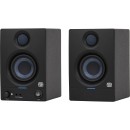
PreSonus ERIS 3.5BT |
VS | ||
|---|---|---|---|
| Active 2-Way | Monitor Type & Configuration | Active 2-Way | Active 2-Way |
| 25 W RMS per Monitor | Total Power Output | 25 W RMS per Monitor | 25 W RMS per Monitor |
| 1x 1" / 25.4 mm Silk Dome | Tweeter | 1x 1" / 25.4 mm Silk Dome | 1x 1" / 25.4 mm Silk Dome |
| 1x 3.5" / 11.4 cm Cone |
Woofer |
1x 3.5" / 11.4 cm Cone |
1x 4.5" / 11.4 cm Cone |
| 80 Hz to 20 kHz | Frequency Range | 80 Hz to 20 kHz | 70 Hz to 20 kHz |
| 2x 1/4" TRS Balanced Input 1x Stereo 2RCA Unbalanced Input 1x 1/8" / 3.5 mm TRS Unbalanced Input 2x Binding Post Pair Output 1x 1/8" / 3.5 mm TRS Headphone Output |
Audio I/O |
2x 1/4" TRS Balanced Input 1x Stereo 2RCA Unbalanced Input 1x 1/8" / 3.5 mm TRS Unbalanced Input 2x Binding Post Pair Output 1x 1/8" / 3.5 mm TRS Headphone Output |
2x 1/4" TRS Balanced Line Input 1x Stereo 2RCA Unbalanced Line Input 1x 1/8" / 3.5 mm TRS Unbalanced Line Input 1x 1/8" / 3.5 mm TRS Unbalanced Headphone Output 2x Push Terminal Passive Speaker Output |
| Digital Audio I/O | |||
| Network I/O | |||
| Bluetooth | Wireless | Bluetooth | |
